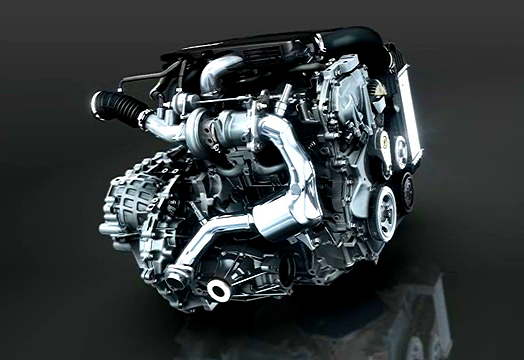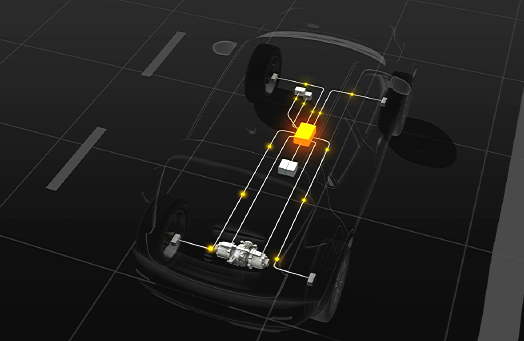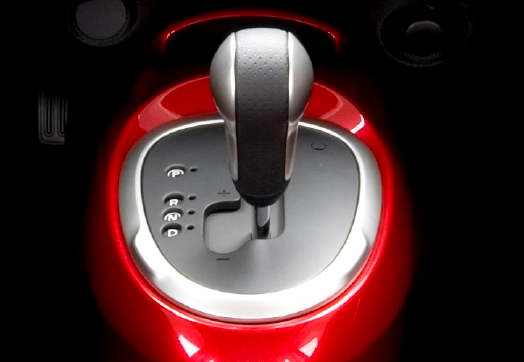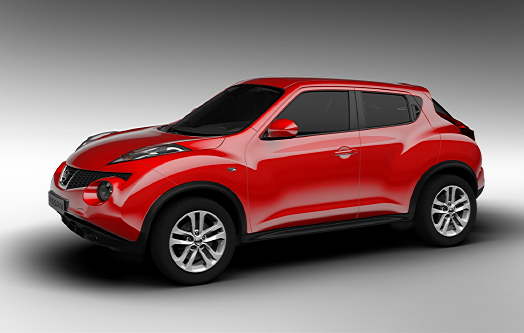Nissan is taking the crossover idea down a size with the Juke, which has the compact dimensions of the Nissan Note but the style and attitude of the Qashqai. Debates rage about whether the styling hits the spot, but the Juke is just as interesting under the skin.
Platform
Juke is based on the Renault Nissan Alliance’s B-platform, already used by Nissan for the Micra, Note and Cube and by Renault for the Twingo, Clio and Modus.
Juke rides on the same 2530mm wheelbase as the Cube but is longer (at 4135mm) and has the widest track of any B-platform car at 1525mm.
Engines
Juke will be available with a choice of three engines and three transmissions – two manual gearboxes and a CVT automatic. For Europe, all the engines are fully Euro 5 compliant.

The most powerful engine is the MR16DDT (above) a new 1.6-litre in-line four-cylinder petrol unit with 16 valves and direct injection.
The new engine incorporates a diamond-like carbon (DLC) coating for the valve lifters and a mirror finish for the camshafts to reduce friction.
Variable timing is provided on the intake and exhaust valves, with extra overlap allowing exhaust gas recirculation – presumably to reduce emissions of nitrogen oxides (NOx).
Turbocharged and intercooled, this lightweight engine develops 190PS and 240Nm of torque – said to give it the performance of a conventional 2.5-litre unit but with much greater fuel economy.
In two-wheel drive versions of the Juke this engine will be coupled to a six-speed manual transmission, while four-wheel drive versions get Nissan’s XTRONIC CVT transmission, which incorporates a six-speed manual mode.
The second petrol engine, another 1.6-litre, 16-valve unit but this time normally aspirated, is a revised version of the HR16DE unit already in used by both Nissan and Renault.
For the Juke, it has undergone a number of significant changes with a larger exhaust manifold, a retuned intake manifold, twin VTC variable valve timing, improved intake tumble flow and new catalyst with a hexagon cell formation.
New pistons with revised crowns and integral oil jet cooling have been adopted along with low friction techniques such as diamond-like carbon (DLC) coating on the valve lifters.
But the most significant change has been the development of a dual injector system – said to be a world first – which has two injectors for each cylinder. The injectors have smaller nozzles so they deliver finer, more closely targeted sprays of fuel into the cylinders for more effective atomisation, which leads to complete combustion.
The revised HR16DE produces 117PS, 6% better than previous versions of the engine. Torque has improved by 3% to 157Nm, and economy figures show a 5.6% improvement.
The normally aspirated petrol engine powers two-wheel drive versions only, and will be available with either the five-speed manual or an XTRONIC CVT.
The final engine choice is the Renault Nissan Alliance K9K 1.5-litre dCi turbocharged common rail diesel, familiar from other Renault and Nissan vehicles including the Micra and Qashqai.
In this form is develops 110PS at 4000 rpm and 240Nm of torque at 1750 rpm. Emission control systems include a diesel particulate filter (DPF), with a fifth injector (which adds extra fuel to prevent the filter clogging).
The diesel will be available on two-wheel drive models with the six-speed manual transmission.
Transmission

This Nissan Juke will be available in two- and four-wheel drive versions. Depending on the engine selected there are five-speed and six-speed manual gearboxes and two different CVT automatics available.
4x4 system and torque vectoring
Juke will be available with a newly developed version of Nissan’s ALL-MODE 4x4-i electronic all-wheel-drive system. By default this drives the front wheels only, but can split torque 50/50 front to rear and can also now split torque from side to side across the rear axle.
This ‘torque vectoring’ system is similar to that recently introduced on much more expensive vehicles like BMW’s X6 and the new Porsche 911 Turbo. Nissan says the Juke’s torque vectoring system is noticeably lighter and more compact than other systems.
All torque vectoring systems follow a similar layout, with a system of gears which can transfer torque from one side of the rear axle to the other under computer control.
By monitoring vehicle speed, wheel speed, gear, steering angle, lateral acceleration and vehicle yaw (turning) rate, the system can channel more torque to the outside rear wheel in corners to cut understeer and enhance the Juke’s cornering ability. Nissan says up to 50% of the total available engine torque – in other words, the whole output of the rear axle – can be sent to either rear wheel.
Though the technology has been seen before, it's interesting that Nissan has decided to use it on such a small and (relatively) low-priced vehicle.
The manual transmission, in five-speed and six-speed versions, has been carried over largely unchanged from Qashqai.
The XTRONIC CVT unit used with the non-turbo 1.6-litre petrol engine is 10% shorter than before and 13% lighter, while internal friction has been reduced by a remarkable 30%.
Nissan claims that this unit is the world’s first CVT with a sub planetary gear, allowing a far higher transmission ratio – 7.3:1 – than previous Nissan CVTs. Smaller, lighter pulleys, a flexible lock up damper and a more efficient oil pump all promote great fuel efficiency.

The XTRONIC CVT with six-speed manual mode, which is available in the turbocharged petrol-engined Juke, has been tuned for a more sporting performance with revised manual modes which are said to offer sharper acceleration.
Suspension
The Juke’s front suspension is conventional supermini, with MacPherson struts. The Juke adds a subframe which is said to improve the stiffness of the front end, reducing sideways deflection to improve handling and ride comfort.
While two-wheel drive Jukes have a torsion beam rear suspension which is common on superminis, the four-wheel drive versions get a new multi-link rear suspension similar to that on the Qashqai.
Nissan claim the Juke’s roll centres front and rear are low, improving rough-road stability and leading to handling at the top of the supermini class despite the higher centre of gravity inevitable in a crossover with generous ground clearance. Speed sensitive electric power steering is standard on all models.
One novelty is that Juke incorporates a ‘ring structure’ which connects the upper body to the rear suspension mountings to increase torsional rigidity, benefiting ride and handling.
